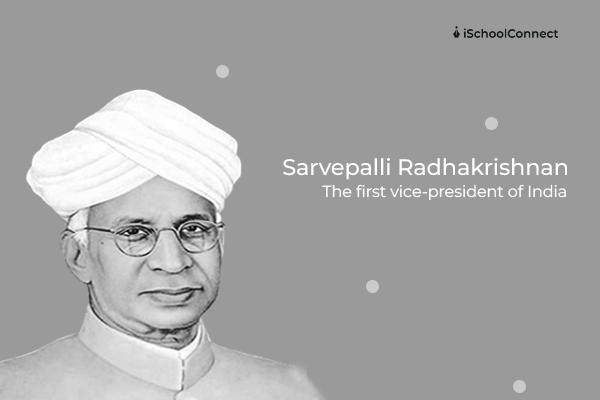Table of Contents
- Dr. Sarvepalli Radhakrishnan | An introduction to his life!
- Who is Dr. Sarvepalli Radhakrishnan?
- Childhood and early life of Dr. Sarvepalli Radhakrishnan
- Education of Dr. Sarvepalli Radhakrishnan
- Achievements of Dr. Sarvepalli Radhakrishnan
- Contributions of Dr. Sarvepalli Radhakrishnan in the field of education
- Interesting facts about Dr. Sarvepalli Radhakrishnan
- Key takeaways
- FAQs
Dr. Sarvepalli Radhakrishnan | An introduction to his life!
India celebrates Teachers’ Day on September 5 every year to honor the relationship that exists between disciples and their respective mentors who have a significant impact on their lives. Education institutions in India commemorate this day by paying homage to Dr. Sarvepalli Radhakrishnan. He shaped the minds of young India and impart knowledge through his published works.
Who is Dr. Sarvepalli Radhakrishnan?
Every year on September 5, Teachers Day is observed to commemorate the birth anniversary of Dr. Sarvepalli Radhakrishnan, who served as India’s first Vice-President from 1952 to 1962 and was also an eminent teacher and philosopher.
Additionally, Dr. Sarvepalli Radhakrishnan served as India’s second president (1962-1967). Despite all of his successes and achievements, Dr. Radhakrishnan remained a teacher all his life. He thought that the brightest brains in the country should teach us how to think for ourselves, making them genuine teachers. Let’s now take a look at his life in detail.
Childhood and early life of Dr. Sarvepalli Radhakrishnan

- Sarvepalli Radhakrishnan was born on September 5, 1888, in a Telugu Brahmin family in a small place in the Madras Presidency, British India, named Tiruttani.
- His mother’s name was Sarvepalli Sita, and his father was Sarvepalli Veeraswami. His father was a subordinate revenue officer working for a zamindar in the area.
- His family originates from Sarvepalli village in the Nellore region of Andhra Pradesh. He was raised in the cities of Tirupati and Tiruttani.
Education of Dr. Sarvepalli Radhakrishnan
- Radhakrishnan received many scholarships during the course of his academic career.
- He attended Thiruttani’s K.V. High School for his elementary education.
- He received his high school education at Vellore’s Voorhees College. At 17, after graduating with a First of Arts, he enrolled in Madras Christian College. He graduated from the same university with both his bachelor’s and master’s degrees in 1906.
- He wrote his undergraduate thesis named The Ethics of Vedanta and its Metaphysical Presuppositions. He created it in response to suspicions that the Vedanta philosophy ignored ethical issues.
- His dissertation received praise from his professors. In fact, his thesis was published while he was still in college and was only 20 years old.
Achievements of Dr. Sarvepalli Radhakrishnan

- He became Andhra University’s Vice-Chancellor between 1931 and 1936.
- He was also elected as Banaras Hindu University (BHU) ‘s Vice-Chancellor from 1939 to 1948.
- He became India’s representative at UNESCO from 1946 to 1952.
- He also served as India’s ambassador to the Soviet Union from 1949 to 1952. After that, he was elected as independent India’s Vice-President in 1952.
- He became India’s second President in 1962, succeeding Dr. Rajendra Prasad.
- Dr. Sarvepalli Radhakrishnan was also honored with Bharat Ratna in 1954.
- He was the first individual to win Sahitya Akademi Fellowship, the highest Sahitya Akademi distinction.
- He also received the “Templeton Prize” for encouraging nonviolence, love, and wisdom amongst people in 1975.
Contributions of Dr. Sarvepalli Radhakrishnan in the field of education
As per Dr. Sarvepalli Radhakrishnan’s beliefs, education is acquiring knowledge outside the conventional modes of academia. He believed education was meaningless if we restrict to rote memorization of facts and figures or bookish learning. It should not overstuff the mind with pointless information. It is also unacceptable to memorize other people’s ideas and use them verbatim on exams to earn certificates and degrees needed for work.
Dr. Sarvepalli Radhakrishnan’s most significant contribution to education is the University Education Commission Report (1940–1949). According to this report, he recommended –
- The practice of yoga, science, literature, morality, ethics, political science, geography, agriculture, and philosophy.
- Education is important to usher in democratic processes in the nation. It is a source to keep in touch with one’s culture.
- Self-improvement is an essential aim of education.
- Education should be such that it instills a purpose in one’s life, making it worthy and meaningful.

Interesting facts about Dr. Sarvepalli Radhakrishnan
- In 1962, when Dr. Sarvepalli Radhakrishan was elected as India’s second president, his students got in touch with him to ask if they might designate September 5. In turn, Dr. Radhakrishnan suggested that September 5 can be observed as Teachers’ Day to recognize teachers’ contributions to our society.
- When he was elected as the second President of India, Dr. Radhakrishnan only took home ₹ 2500 of his ₹ 10,000 monthly pay; the rest went to the center’s National Relief Fund.
- Oxford University created the Radhakrishnan Memorial Award and the Radhakrishnan Chevening Scholarships.
- He received the Knighthood in 1931, following which he was called Sir Radhakrishnan. It was only after 1947 when he got his former name (Dr. Sarvepalli Radhakrishnan) back.
- He was named the Spalding Professor of Eastern Religions and Ethics at Oxford University in 1936. He was also selected for a fellowship at the All Souls College.
- He founded Helpage India, a nonprofit organization for the elderly and underprivileged.
Key takeaways
- The country celebrates Dr. Sarvepalli Radhakrishnan’s birthday as Teacher’s Day in his honor. He was a brilliant teacher who was loved by his students for all good reasons.
- The life and achievements of Dr. Sarvepalli Radhakrishnan in Indian education and philosophy are priceless.
- On Teacher’s Day, marking his birthday, students throughout the country express their gratitude for the sacrifices and efforts made by their teachers, who have influenced their lives.
- As proud Indians, we continue to remember him and his contributions to Indian society and celebrate the auspicious occasion of Teacher’s Day with love and compassion just how he envisioned it.
We hope you found this blog informative. You can reach out to us or drop a comment to share your thoughts.
Liked this blog? Read more: Ratan Tata: An inspiring success story of humanity and ethics
FAQs
Q1. Where was Dr. Sarvepalli Radhakrishnan born?
Answer- Dr. Sarvepalli Radharishnan was born in Tiruttani, Madras Presidency (now Tamil Nadu), British India.
Q2. How many times was Dr. Sarvepalli Radhakrishnan nominated for the Nobel Prize?
Answer- Dr. Sarvepalli Radhakrishnan received a record-breaking 27 nominations for the Nobel Prize (in literature and for peace).
Q3. When did Dr. Sarvepalli Radhakrishnan die?
Answer- Dr. Sarvepalli Radhakrishnan died on April 17, 1975.






